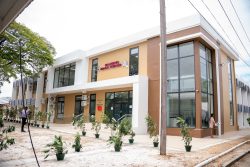The current global food crisis and the need for an urgent and energetic CARICOM response that seeks to address regional food security underscores the critical importance of Guyana’s agricultural sector to the region’s capacity to feed itself. Serious though the crisis is, there is little doubt that Guyana’s food production capacity can make all the difference to the regional response.
The current regional food security problem, of course, cannot be attributed solely to rising global food prices. Regional Ministers of Agriculture attending the recently concluded COTED meeting in Georgetown have conceded that the community as a whole has, over the years, been less than attentive to the importance of its food security. Intra-regional focus on agricultural production has declined in favour of high volumes of extra-regional food imports and what has brought CARICOM to its senses is the fact that it simply cannot afford the luxury of a US$3b plus annual imported food bill, a belated discovery that surely raises serious questions about the priorities of some, perhaps most member countries.
The opportunity for Guyana to play the lead role in helping the region respond to the consequences of what is, in large measure, its own shortsightedness by taking its own agricultural potential far more seriously is reflected in the attention that is now being paid to what Guyana has to offer. Both the private and public sectors in some member states are now paying close attention to the potential for investment in both joint venture projects in the country’s agricultural sector as well as in land lease arrangements for independent projects. Additionally, the endorsement by the recent COTED forum of the Jagdeo Initiative as the ‘blueprint’ for a regional food security plan that has now become – arguably – the lead item on the CARICOM agenda attests to the central role that Guyana will now be required to play in influencing regional agricultural policy. It is, in the circumstances, a huge responsibility.
Interestingly, it is to the local private sector as much as the government that we must look for the actualization of a sound regional food security plan, since, while issues like land allocation and investment regulations come under the government’s purview, agricultural production – with the exception of sugar – is largely a private sector pursuit. The regional food security initiative, therefore, promises to open up new and promising opportunities for local farmers and agro-processors in joint venture projects and greater access to regional markets. Regional private sector investments in local agricultural ventures could of course mean a greater injection of capital for expansion, investment in machinery and the application of upgraded farming methods. Local farmers will of course be challenged to increase production in order to meet local and regional demand.
It is here, of course, that the government is challenged to work with the private sector to provide every possible encouragement and incentive for agriculture in order to maximize the opportunity arising out of the increased intra-regional demand for food. The expeditious facilitation of land lease arrangements, the enhancement of the capacity of the roles of the National Agricultural Research Institute (NARI) and the Guyana School of Agriculture, the removal of such tariffs and duties as may exist on agriculture-related goods, the fast-tracking of investments in the agricultural sector and support for the regional and extra-regional marketing of agricultural produce are incentives that come immediately to mind.
Another important challenge facing Guyana if it is to respond to the task of helping enhance regional food security is that of creating an improved drainage and irrigation facility in the existing agricultural regions – as well as in those new areas that will presumably be opened up to agriculture – in order to stave off the worst excesses of flooding and the consequential crop losses.
There are of course various spin-offs that are bound to accrue to Guyana once it assumes the lead role in the regional food security drive; spin-offs like improved research facilities; the expansion of existing agricultural holdings and the creation of new ones; increased employment in the agricultural sector; the opening up of new agricultural lands and the application of upgraded technology in the sector. For Guyana, the focus on enhancing regional food security offers what is perhaps an unprecedented opportunity to play a critical leadership role within CARICOM.








